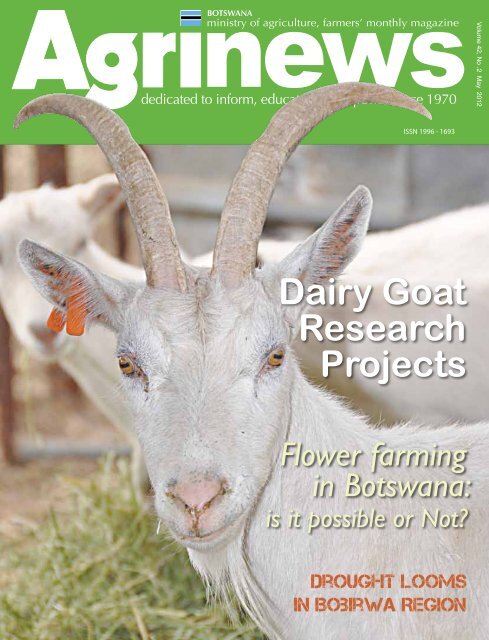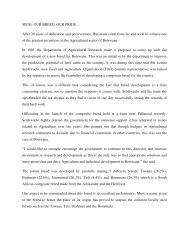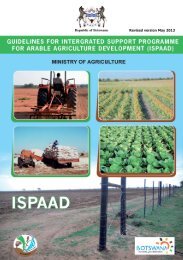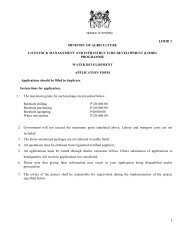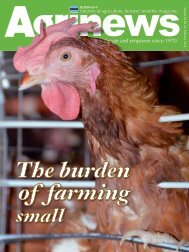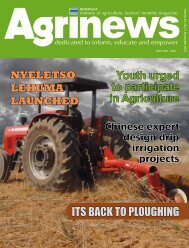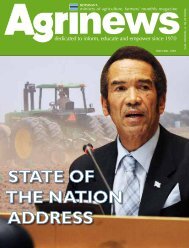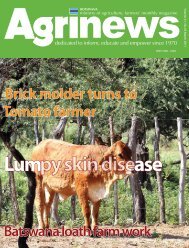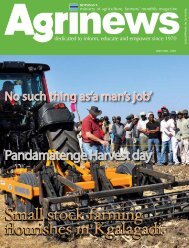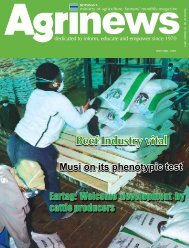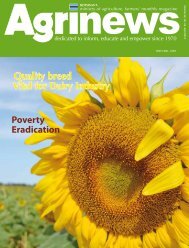Dairy Goat Research Projects - Ministry of Agriculture
Dairy Goat Research Projects - Ministry of Agriculture
Dairy Goat Research Projects - Ministry of Agriculture
Create successful ePaper yourself
Turn your PDF publications into a flip-book with our unique Google optimized e-Paper software.
Volume 40, No. 06 June 2010BOTSWANABOTSWANAdedicated to inform, educate and empower since 1970Volume 41, No.03 March 2011Prickly pear -an ideal crop for BotswanaLivestock;every man’s prideGantsi showinspires multitudesPermaculture anopportunity for youthBrick molder turns toTomato farmerLum aseBatswana loath farm workAGRINEWS MagazineAdvertising RatesSpecial pagesInside front PageFacing inside coverInside coverCentre spreadDouble pageBack coverFull colorP2150P2150P2000P4000P4100P2250Inside pages B/W 1spot 2spot Full colourFull page 1100 1150 1200 1250Half page 750 850 950 1000Quarter page 190 290 490 540MoA Grafix - Ik KgaodiContacts: Moesi - 368 9174; Ignacious - 368 9130; Mokgarebe - 368 9149/75. Fax: 390 6769e-mail: mmoesi@gov.bw / ikgaodi@gov.bw /mmotswakhumo@gov.bwMay 2012
LENANEO LA DITSHUPO TSA TEMO THUO, 2012REGION DISTRICT DATE VENUECONTACTSSouthern(Kanye) 1. JwanengPitsengDAO 58031002. Mmathethe MotsentseDAO 54000863. Kanye KanyeDAO 54402794. Moshupa ManyanaDAO 54491125.GoodhopeGood hopeDAO 5486231Western (Kang) 1. Ghanzi 23-25 June 2012GhanziDAO 6596217Ms Makabeletso L/board 65962362. TsabongTsabongDAO 65403003. HukuntsiTshaneDAO 6510261/242Maun1.Ngamilandwest(Gumare)2. NgamilandEast(Maun)27,28 July 2012Gumare6874055/91-4 Aug 2102MaunDAO 6860579/2303. Chobe ( Kasane) 29-30 June 2012PandamatengaDAO 62502114. Okavango(Shakawe)ShakaweDAO 6875040Francistown 1. Masunga No showSekakangweDAO 24898892. Tonota 20,21, 22 July 2012TonotaDAO 24842613. Tutume 27,28,29 July 2012TutumeDAO 2987310 / Chizhala 72914725Central( Serowe)1. Bobonong 29,30,31 June 1 JulyBobonong DAO 2619218 / 357 / 7255496520122. Selebi-PhikweMmadinare DAO 26149203. Serowe 28,29,30 June 2012Serowe DAO 4635373 Boyce Sekgoma 719202274. Boteti ( Letlhakane) 6,7,8 July 2012Makalamabedi DAO 29783255. Mahalapye 3,4,5 August 2012Mahalapye DAO 47106766. Machaneng 20,21,22 July 2012Machaneng DAO 49402387. Palapye 6 - 7 July 2012Maunatlala DAO 4920240Gaborone1. Kweneng South 3,4,5 August 2012Molepolole DAO 59210512. Kweneng NorthLentsweletau DAO 57792073. Mochudi 25 July 2012Mochudi DAO 5777257 / 57100684. RamotswaRamotswa DAO 5390222/9105. Kweneng West 26 – 28 July 2012Letlhakeng DAO 5943017/72161096/73393998/71920227NATIONAL AGRIC27 Aug - 1 SeptGaborone Secretariat 3689132/ 9116SHOW2012Key - DAO - District Agricultural Office.C/E - Crop exhibitio Fax: - 3906769May 2012
VISIONFOUNDATIONPILLARSLEST WE FORGETeditor’s noteAttain national food securityand global competitivenessin agricultural productsMISSIONTo improve agricultural productivitythrough technology developmentand transfer, diversification andcommercialization, inorder to promote food security inpartnership with our stakeholders.VALUES1. BOTHOWe treat our customers ina respectable and caring manner.2. TEAM WORKWe recognize the need to work asa team characterized by collectiveeffort, trust, understanding,support and perseveranceirrespective <strong>of</strong> rank or gender.3. CUSTOMER FOCUSEDOur customers are the focus<strong>of</strong> everything we do by beingcourteous, caring, compassionate,tolerant and empathetic.4. INNOVATIVEWe commit to employ new ideasand being proactive in order tomatch the requirements <strong>of</strong> thefuture.5. INTEGRITYWe foster a culture <strong>of</strong> transparency,accountability and dependability.Though not well versed in thestory <strong>of</strong> evolution <strong>of</strong> man, the storyremains a marvel. What is clearis that man has traversed throughthe bushy, thorny, dark and brightbushes <strong>of</strong> life. Yet he survivedthose difficult terrains.Perhaps one may ask with thisfamous corrupted phrase ‘ if theydid it, why can’t we did it?’ That isthe question to arable farmers.It was a bad day at the <strong>of</strong>ficefor arable farmers this ploughingseasons due to lack <strong>of</strong> rainfall.Figures show that compared tothe past two years, the number<strong>of</strong> farmers who ploughed hassignificantly dropped. This ismostly due to adverse weatherexperienced in the last season.Lest we forget, this is the time weshould start preparing for the nextploughing seasons. We cannotafford to relax on the basis that itwas a bad year.The little food some managedto salvage from their fields shouldnot lead to desperation. Instead,we should start now to evaluateand come up with better ways to beatthe weather to produce food for thecountry.I want to reiterate that the farmingcommunity has a contract to fulfillwith Batswana; to feed this country.Failure to feed this country could leadto a backlash from our clientele.Therefore, we should considerusing the latest farming technologiesto enable ourselves to beat the evererratic rainfall.It is only those who have the zealand utilize new technologies that cansurvive these hard times. Therefore,the proverb ‘ survival <strong>of</strong> the fittest’ alsoapplies to the farming community.What it means is that for a farmer tosurvive in this difficult times, he/shehas to be amongst others innovative.Remember the story <strong>of</strong> evolution <strong>of</strong>a man. According to that story, onceupon a time, man used to walk onfour legs.Walking on four legs is now history,the story unbelievable to some. Thisevolution <strong>of</strong> man shows that man isever creative and innovative, so let ustranslate that to farming.1May 2012
oject<strong>Dairy</strong> goats at Morale ranch in Mahalapye.Besides that the does are carryinga heavy weight to roam around, shefurther said, “The udder is your assetand has to be protected from injuriesby thorns on Acacia species plants.Losing an udder is like losing a dairygoat.”Asked whether the goat milk hasa competitive urge over the widelyused cow milk, Mpapho said goatmilk is richer in nutritional value withvitamin A, niacin, choline, inositoland selenium hence has healthbenefits.“The therapeutic properties <strong>of</strong> goatmilk are well known such that themilk can be recommended in cases<strong>of</strong> dyspepsia, peptic ulcer, liverdysfunction, jaundice, pyloric stenosis,eczema and to those intolerant/allergic to cow milk especially infantsand growing children.”Economically, she said, goat milkis cheaper compared to that <strong>of</strong> cows.The research project is funded byBotswana College <strong>of</strong> <strong>Agriculture</strong>through the <strong>Research</strong> and PublicationCommittee.“..in 2011, through this researchproject we acquired some funds from“The Regional Universities Forum forCapacity Building in <strong>Agriculture</strong>”(RUFORUM) to sponsor two MScstudents who will do a researchproject entitled “Poverty alleviationand increased food security throughi m p r ov i n g s m a l l h o l d e r m i l kproduction <strong>of</strong> dairy goats and theircrosses in Botswana.” This is a way<strong>of</strong> promoting dairy goats in Botswana.DAR dairy goat research project:Mahalapye – Morale RanchMorale Ranch in Mahalapyeoperating under the DAR started itsdairy goat research project in 2005and is expected to roll out to thecommunity in 2014.Orwell Marobela, the Small StockProgramme Leader in Mahalapye<strong>of</strong>fice said the project assesses theadaptability and milk production<strong>of</strong> Toggenburg, British alpine andSaanen dairy breeds. On average, hesaid, the potential production <strong>of</strong> allthree breeds ranges between 6 to 8liters a day. However, he lamentedpoor performance <strong>of</strong> all the breedswith Saanen being the best producing4 to 4.5 liters a day. Lagging behindproducing between 3 to 3.5 liters, hesaid is British Elpine.“Performance is poor in Botswanabecause <strong>of</strong> heat stress and diseasesuch as heart water disease,” Marobelafurther explained.Marobela said the breeds arenot acclimatizing to the conditionssignaled by high mortality rate <strong>of</strong>the young and old goats from heartwater disease. Their attempt to curbthe challenge with vaccinations forthe diseases proved futile.Already, Marobela stated thatthere have started cross breedingwith the Tswana goat which copesunder Botswana climatic conditions.Currently, the ranch has 60 hybridsand 30 pure breeds and theirproduction rate does not differ much.“Tswana goat milk production is toolow but can survive the Botswanaclimatic conditions. So we are hopingto get the competitive urge <strong>of</strong> eachby crossing breeding the two breeds.”Maintenance <strong>of</strong> these goats,according to Marobela is expensiveespecially the feed. He said all thegoats consume 8 bundles <strong>of</strong> feed aday. The evidence, he asserted wasalso true for the two farmers who triedthe project and failed because <strong>of</strong> thehigh operation costs.Marobela said they are consideringexperimenting the project in a freerange even though the stakes arehigh. Ideally, he stated, the project isaimed at commercializing goat milkproduction through cooperatives. Tointroduce dairy goat farming to thefarmers, he said bucks are annuallysold through auctions to the farmers,so that they can cross breed andimprove their flock.Marobela said the success <strong>of</strong> theproject will curb the low production<strong>of</strong> milk in Botswana. Further, he notedit will satisfy the appetite <strong>of</strong> goatmilk especially in tea that Batswanatraditionally like. He clarified thatmost goat milk available in shops areimported from South Africa, henceexpensive for an average Motswana.Saanen goats feeding at BCA3May 2012
Farmers plead with minister to act quickly.Drought loomsin Bobirwa RegionArticle & Photos: Segomotso Basuti“If assistance does not comeimmediately, it will come at atime which it will no longer benecessary as all the cattle would haveperished.”Though the Minister <strong>of</strong> <strong>Agriculture</strong>,Mr Christiaan De Graaff, broughtreassuring news to Bobirwa regionthat the Foot and Mouth Disease(FMD) situation was now undercontrol, residents had more problemson their plate. Their main worry wasthat with the winter approaching,kraals will be shut down due to thedisease’s horrendous outcomes.“The Foot and Mouth Diseasehas had us living in discomfort formore than eight years, we fear that ifthis continues we will be left emptyhanded as we are now watching ourcattle perish due to drought,” said theFarmers Committee Chairperson, MrKeitseng Morake.The farmers’ plea is for thegovernment to consider selling theircattle to Zimbabwe as is the case withthose in Ngamiland District.Currently, they are not sellingtheir cattle anywhere. There is n<strong>of</strong>resh grass for grazing and droughtis evident from afar. The situation isharshly impacting on them due tohigh labour costs and fuel used intheir farms.“If assistance does not comeimmediately, it will come at a timewhich it will no longer be necessaryas all the cattle would have perished.”Farmers expressed grief on issuesthey felt held them back to performbetter, one <strong>of</strong> them being facilitieslike abattoirs which they said aremandatory to be in good workingconditions at all times in order fortheir farming to run smoothly.“Abattoirs here are hardly in goodcondition, when they are, it is onlyfor a maximum <strong>of</strong> two weeks,” saidMonamati Marope, a farmer fromLephokwe Cattle post.On his part, the minister expresseddisappointment in that they continuedto disregard government plea not tohire illegal immigrants. He said thisplayed a major role in the spread <strong>of</strong>the disease.“There is a constant risk <strong>of</strong> transboundaryspread <strong>of</strong> the disease fromthe neighboring countries, wherethe disease occurs and transmissionis facilitated by the rampant illegalcross-border human and livestockmovement.”As an initiative to help FMDstruck regions, in 2011 BMC startedexporting live cattle to Zimbabwe.The minister told the residents thatnegotiations are in process withthe Zimbabwe market to ensurethat Babirwa are not left out in thisexporting process. It is with nodoubt that the Zimbabwe marketwill at some point be saturated. Theminister assured the farmers thatthey are seeking markets elsewherein preparation for such predicament.With the process <strong>of</strong> restocking cattlein the Bobirwa region scheduled soon,the minister assured them that theprocess will be as transparent aspossible. He said that cattle used forrestocking will be purchased fromwithin zone 7.“However, only good quality, younganimals with good temperament willbe sought,” he said.The minister acknowledged thatthe pain caused by the FMD t<strong>of</strong>armers was indeed a dishearteningone. He, however, thanked themfor their cooperation, support andcommitment in trying to bring thesituation to a halt.May 2012
Stock CommercialFarmerArticle: Keamogetse BoitshepoPhotos: Aggripah WillieAgood number <strong>of</strong> Batswanayouth are embracing theconcept <strong>of</strong> taking farming asa business. This is opposed to the idea<strong>of</strong> viewing farming as a hobby whilepursuing a white collar job. At 28years <strong>of</strong> age, Tshwarelo Marebolo hasstarted his journey as a commercialfarmer.Marebolo who started <strong>of</strong>f with70 goats has now expanded hisbusiness and keeps sheep as well. Byfar, he confessed that maintenance<strong>of</strong> sheep is similar to those <strong>of</strong> goats.However, he said considering thetype <strong>of</strong> breed to keep is a veryimportant consideration. This, he said,is influenced by the fact that foreignbreeds have bigger frames than localTswana breed, therefore ideal for meatproduction farming businesses.Nevertheless, Marebolo said the cost<strong>of</strong> maintaining foreign breeds is highbecause they are not acclimatized toBotswana conditions. According tohim, this results in high mortality rateand reduced production. Whereasthe Tswana breed copes well withthe local climatic conditions. As such,Marebolo choose to keep the Tswanagoats and a hybrid <strong>of</strong> Boer and Tswanabull.“The pure Boer breed needs highmaintenance and many vaccinesto survive in Botswana. While theTswana breed needs just the basicvaccines to survive,” Marebolo stated.Marebolo, who however, admitsthat he still has a lot to learn sayshybrids prove to be better as it hascharacteristic <strong>of</strong> both parents. To hisexposure, the animals tend to havethe growth ability <strong>of</strong> the foreign breedwhile adopting to some resilientattributes from the Tswana parent.“Mixed breeds grow faster and havemore meat hence good for business,”he stated.When his business grows, he vowsto start keeping Boer breed whichare his love and seem to adopt betterto Botswana climatic conditions. Hesaid by then his business would beable to sustain itself and afford theexpenses that come with keepinga foreign breed. He also said hewould have acquired education andskills on running ruminates farmingproduction.“I am planning to bench mark withthe best in the industry to learn goodmanagement ideas. I believe that Iwill then run my business effectively,”optimistic Marebolo said.Other means <strong>of</strong> getting educatedon the subject that Marebolo intendsto explore include attending shortcourses and workshops. He said byso doing ,he will better his chances<strong>of</strong> doing well and manage to pay <strong>of</strong>fhis loan.Marebolo said his agreement withthe Department <strong>of</strong> Youth is that hepays 50% <strong>of</strong> the P92 667 that he wasloaned to start up his business. Heasserted that he had already startedpaying up the loan that he is supposedto finish paying in 2015. Mareboloadmits that it takes determination notto default in his kind <strong>of</strong> business sincebusiness comes not <strong>of</strong>ten.“When I sell animals in bulk at onetime, I pay a lump sum for a couple<strong>of</strong> months in advance. This is to makeup for the time the business is slow,”he said.Since he started business mid 2010,he sold his flock’s first <strong>of</strong>f springssometimes in 2011 and had a goodreception in the market. He said hehad business from the department <strong>of</strong>youth buying for starting up youths,butcheries and individuals.“The market was open for differentproducts at competitive prices. I soldkids and pregnant females at verygood prices,” he said.Marebolo is even more determinedsince he has seen rewards for his efforts.He said improving his managementtactics to reduce the mortality rate isone <strong>of</strong> his strategies. He confessedhaving lost a good number <strong>of</strong> goatswhen he started the project because<strong>of</strong> failure to vaccinate. However, hecurrently developed a check systemwhereby he ensures that animals arevaccinated accordingly. Also, everymorning he attends to any animalshowing weakness.“I keep terramycin to give to thosethat are not in good health. I alsokeep tick grease to curb the threats<strong>of</strong> a tick that is prevalent in the cattlepost,” Marebolo stated.He said this strategy allows him toeffectively deal with the tick problemand any other disease. He said if theticks are not dealt with right away itthey kill goats in a similar way likelungs infections.Marebolo does not have a herdman as he takes care <strong>of</strong> his businessfull time. He stays in Gatalatau cattlepost near Shoshong where he keepshis animals.May 2012
COMMISSOF UHTAT NFIN KAMay 2012
in Botswana:has a diverse and unexploitedindigenous flora which can beused as cut flowers and landscapeplants. The indigenous flora hasadapted to the harsh conditions.The use <strong>of</strong> indigenous flora willalso reduce the dependence onthe exotic flowers which are notsuitable to conditions in Botswana.5. Many farmers complain <strong>of</strong> highoperational costs because <strong>of</strong>our climatic conditions, whatoperational costs would one incurin operating a flower farm?Answ. The operational costsinvolved in running a flowerbusiness include electricity costsfor keeping the flowers in the coldstorage at the correct temperature,transport to and from the market isone <strong>of</strong> the biggest costs in runninga flower farming business. As perthe climate, the initial cost wouldbe for setting up greenhouses ifthe farmers choose to grow underprotection and then the control <strong>of</strong>pests and diseases.6. What are common challengesin floriculture?Answ. The common challenge infloriculture would be maintaininga cool chain in cut flowers.This affects the post-harvestperformance and vase life <strong>of</strong> theflowers. Another challenge is theincidence <strong>of</strong> Botrytis rot whichis also related to the cool chain.This disease can cause extensiveeconomic losses in roses andgerbera flowers. A challenge thatwould affect Botswana directlywould be transport. Airfreight isexpensive and one <strong>of</strong> the cheapermethods is sea freight and sinceBotswana is landlocked it cannottransport flowers by sea excepteither by air or road.7. Take us through the process<strong>of</strong> planting floriculture crops,from soil preparation toplanting?Answ. Selection <strong>of</strong> site shouldbe near the market or airport ifexporting. Look within the radius<strong>of</strong> 200km <strong>of</strong> the airport or market.Climatic conditions, look atmacro and micro climate;Site preparation: if the plantsare to be planted on the soil, asoil analysis is needed. Do a soilpr<strong>of</strong>ile. A soil depth <strong>of</strong> 1- 1.2 mwould be ideal.Water: the quantity and quality<strong>of</strong> water is essential. Good qualitywater should have an EC not higherthan 0.25mS/cm. Average waterneeded is 4 – 6 L/m 2 per day. Theamount <strong>of</strong> water needed varieswith flower species and the season.In summer, more water is neededcompared to winter.Planting; Planting flowersdepends on whether you chooseto grow directly on the soil oruse soil-less media. The farmercan also choose to grow underprotection or in the open-field.The advantages <strong>of</strong> using protection(greenhouses) are: control in theenvironment such as temperatureand relative humidity. The use <strong>of</strong>greenhouses also keeps out pestsand diseases and the growingseason can be extended.8. What kind <strong>of</strong> soil is good forfloriculture crops?Answ. The soil needs to have gooddrainage. Ideal soil to grow shouldhave the following properties:Clay- 15-30%, Loam-30%, sand-40%. Soil-less media (hydroponic)is better than growing in the soil.Hydroponicsr e d u c e s t h ei n c i d e n c e so f s o i l - b o r n epathogens. Some<strong>of</strong> the soilless media used infloriculture include rockwool,perlite, peat and sand. The plantshave to be fed the necessaryelements through fertigation.9. What kind <strong>of</strong> maintenancedo the crops need? Is therea need for pesticides andherbicides?Answ. Flowers need regularmaintenance like watering,weeding and control <strong>of</strong> pests anddiseases. The use <strong>of</strong> pesticidesand herbicides has come undergreat scrutiny <strong>of</strong> late and thereforefarmers are encouraged to useother methods such as IntegratedPest Management (IPM), wherebythere is the use <strong>of</strong> the culturalmethods in combination withlimited use <strong>of</strong> chemicals.Cultural methods such as propersanitation in the greenhouse andpackhouse. Pests and pathogens arecontinually developing resistanceto chemicals and the chemicalsharm the environment and theworkers. There are reported cases<strong>of</strong> workers who got illness dueto exposure to chemicals duringspraying.9. What does it take for one toenroll to study floriculture?:Answ. Botswana College <strong>of</strong><strong>Agriculture</strong> <strong>of</strong>fers a BachelorsDegree in Crop Science which<strong>of</strong>fers courses in floriculture,ornamental horticulture. There isalso a module at graduate level forfloriculture.May 2012
less widely used in tropicalcountries.Very susceptible to triztezavirus but resistant to gummosisand “phytopthora” footrot whichcommonly occur in humid tropics;itcan be used on heavier coastal soils.3. Sweet Orange (citrus cinensis).This is used to some extend asrootstock in caribbean and tropicalAmerica.It is generally lower thanrough lemon in fruit yield , e.gmandarins and oranges but the fruitquality is very good.Up to 90% seedsare nucellar.Soils should be welldrained as a sweet orange rootstockis susceptible to foot-rot.Fruit Development: Fruitdevelopment varies greatly in citrusvarieties and may have major effectson yield and tree growth.Lime, inthe humid tropics,tend to come intobearing very early and may fruit soheavily that growth <strong>of</strong> the tree willbe retarded.Oranges in the humidequatorial tropics,as well as lemonsand some mandarins,must be grownat high elevation to flower well.The growing <strong>of</strong> true oranges is bestdeveloped in the American tropics.In the drier tropics,which are mostlyabove 10*latitude,some orangegrowing is sucessful at sea level.Fruit development may be poorbecause <strong>of</strong> self incompatibility andseedlessness.Generally seedlessvarieties or varieties with fewseeds fruit poorly.In this case crosspollination by growing <strong>of</strong> mixedvarieties may be the answer.Climate and Soils:In the humid tropics orangesdo not produce good qaulity fruit.Some varieties <strong>of</strong> orange are grownin tropics but generally qualitydeteriorates rapidly with increasinghumidity.This is probably due to bothtoo much leaf growth and too a lowincidense <strong>of</strong> sunshine which causesfruit develop too fast making themacid and watery.In a continuouslyhumid climate flowering and fruiting<strong>of</strong> oranges is also poor since mostorange varieties need a cool spellto flower.In equatorial regionsthe oranges generally increasein qaulity (sweetness and colour)from a wetter to a drier zone orfrom sea level to higher elevationswhen sunshine is not reduced.However,there is varietal differences.For example valencia oranges canbe grown successfully at sea levelin colombia but navel orangesrequire an elevation <strong>of</strong> about 1000m.Mandarins are similar to orangesin their climatic requirements butgenerally are slightly better adaptedto humid climates.For good growth orange tree requirelight well-drained deep soils.Onsuch soils trees will grow stronly andalso stand periods <strong>of</strong> moisture stress.Varieties and rootstocks susceptibleto foot-rot especially require welldrainedsoil and absence <strong>of</strong> flooding.Caltivation And Management.Propagation and nurseryThere are four different ways <strong>of</strong>propagating citrus(oranges) ,bygraftage,budding, micropropagationor from seed.Generally the first threemust be recommended because seed<strong>of</strong> most good citrus (oranges) varietiescontain out-pollinated genes andproduces variable trees.Uniformitytherefore,may be obtained fromasexual propagation.GraftageThere are two methods <strong>of</strong> grafting.First stock seeds <strong>of</strong> the desiredvariety (rough lemon)are plantedin polythene bags,or on the seedbed.When these reach a thickness<strong>of</strong> about 10mm they are ready forgraftage.This exercise takes about6-12 months in tropical conditions.For cleft grafting a branch <strong>of</strong> adesired variety,such as is used forcuttings,is cut and its end trimmed toa V-shaped.The stock seedling is cut<strong>of</strong>f at a height <strong>of</strong> about 10cm wherethe stem thickness is about 10mmand a V-shape notch is carefully cutin the end into which the abovecutting is inserted.The joint is tapedup with polythene tape.Budding can also be carried outusing T-bud technique.The budgrows on the stock after a fewweeks,the stock seedling is cut backto a joint just above the bud patch.In all types <strong>of</strong> graftage ,the graftedshoot is called the SCION.The scionis allowed to grow to a height <strong>of</strong> 50-70 cm in the polythene bag;duringthis time any shoots coming from13May 2012
the stocks must be pinched <strong>of</strong>f.Thescion shoot must be tied to a stickfor more support ,and to ensure thatit develops straight growth,for thiswill become a trunk <strong>of</strong> the tree.Afterthis; tip <strong>of</strong> shoot is cut back to allowabout 6 strong side (lateral) shoot todevelop. This will form the mainframe <strong>of</strong> the tree.Seedlings may beplanted in the field as soon as theside shoot are growing strongly.In Vitro Propagation <strong>of</strong> CitrusSenensis:A method <strong>of</strong> “In Vitro” propagationfor some citrus rootstocks hasbeen established since 1982 atthe Laboratory <strong>of</strong> the InstitutoSperimentale per L Agrumicoltura<strong>of</strong> Acireale ( Starrantino et al.,1983;(983a).At the beginning, following theexperience <strong>of</strong> Kitto et al.,(1981) and<strong>of</strong> Barlass et al.,(1982),the rootstocks“Troyer” and Carrizo citranges (Citrussinensis L.osbeck * Poncirus trifoliataRaf.) have been micropropagated.Successively the same methodologyhas been applied to the trifoliateorange (P.trifoliata Ref.) “FlyindDragon”. Lately a “dwarf mutant”seedling <strong>of</strong> “Troyer” citrange thatappears promising for use as dwarfrootstock, has been also included inthe program <strong>of</strong> micropropagation.General Management:1) Fertilization:It is sometimes recommendedthat fertilizer be placed in the holewhen the trees are planted. Thispractice has frequently resulted insevere damage to the trees.If thesoil analysis indicate a low level <strong>of</strong>nutrients,then fertilizer should bemixed with the top soil and placed atthe bottom <strong>of</strong> the hole.Alternativelyfertilizer can be more safely appliedto the surface <strong>of</strong> the soil after the treehave been planted.2) Planting:The planting holes or tree sitesmust be marked out with a peg beforeany planting starts,using a steel tapeor preferably a suitable long wirewith the planting distances markedon it.Holes for planting should be60cm*60cm*60cm.If the wholesare unnecessarily deep,there willbe excessive settling after planting .On poor soil, dig large holes and fillthem with good top soil, then allowenough time for the soil to settlebefore planting.The best time toplant citrus is spring time when theweather is warming up.3) Irrigation:After the tree has been properlyplanted,throw up a small basinaround the trees and irrigate themthoroughly. The bottom <strong>of</strong> the basinshould slope towards the tree trunk,so that most <strong>of</strong> the water goes into thehole.Newly planted plants shouldbe protected against soil borne pestsuch as termites.Watering: The most important incaring in caring for young citrustrees ( C. sinensis ) is to see thatthey get sufficient water withoutbeing over-irrigated.Under moistconditions,water every week or tendays during the first year and aboutevery two weeks for the next twoto three years.A longer intervalsbetween irrigations may be necessaryif they grow poorly.If drip or trickleirrigation is used,water is generallyapplied in smaller amounts but morefrequently.After the third year, trees willrequire irrigation every two to sixweeks,according to soil and locality.On sandy soil or in hot weather ,irrigation must be more frequent thanon clay soils and in cool weather.When the trees are established, watermay be applied in farrows or basinsor by sprinklers.The irrigation basin should begradually enlarged as the trees grow,so that it is always slightly bigger thanthe dripline <strong>of</strong> the tree.Be careful notto damage the young trees fine rootsthrough cultivation.4) Cultivation and weeding:It is most important to keepthe area under the canopy free <strong>of</strong>weeds.Weeds may be removed byhand , being careful not to damagethe feeder roots or the trunk whenthe spade or other tools are used.Wounds promote penetration <strong>of</strong>soil pathogens which cause rootrot.Cultivation is necessary only tomaintain irrigation furrows or basinsand to control weeds and grasswhich compete with the trees forwater and fertility.5) Pruning:Avoid pruning young trees asmuch as possible.The removal <strong>of</strong>green leaves retards growth andincreases the time required forthe trees to come into bearing.For the sake <strong>of</strong> appearance, rub<strong>of</strong>f growth on the trunk while itis young and succulant,but leavethe top unpruned until the treesare in bearing.Do not allow anygrowth bellow the graft union asthis may be detrimental to the tree.It is not common practice as it is fordeciduous trees although dead woodis removed routinely.To avoid lowbranches from touching the ground, trees are skirted soon after the cropis removed.Branches touching thesoil hamper removal <strong>of</strong> fruits lying onthe ground and impede irrigation.Italso promotes ant infestation in thetrees.If trees become too big and startgrowing into one another,pruning isrecommended.Control <strong>of</strong> insect pests:The use <strong>of</strong> pesticides should berestricted to a minimum when pestsare to be controlled especially inhome garden.There is a naturalbalance between the insects whichattack the tree and other insects(parasites and predators ) whichlive on the pests.Careless use <strong>of</strong>pesticides will upset this balanceresultng in worse pest problem.Diseases and their control:1) Black Spot. This is the mostimportant disease (which can becontrolled ) in citrus.Symptoms: minute red-brown spotsMay 2012
Quote <strong>of</strong> the month“It is thus with farming: ifyou do one thing late, youwill be late in all your work”-Cato The Elder.Compiled By Segomotso BasutiDid You KnowOn average a hen lays 19 dozen eggs in a year.Did you knowNo two cows have exactly the same pattern <strong>of</strong> spots.Did You KnowIt takes 12 honeybees to produce 1 tablespoon <strong>of</strong> honey.Did You KnowA crocodile cannot stick out its tongue.Did you knowBunches <strong>of</strong> bananas are called “hands” and each hand has about 20 “fingers”Did you knowChickens can live for up to 4 or 5 years in the wild but many commercially farmed chickensusually do not exceed the age <strong>of</strong> one.Did You knowHoneybees never sleep.Did You KnowThe only two animals that can see behind themselves without turning their head are theRABBIT and the PARROT.Did You knowPork is the most widely eaten meat in the world.Did You KnowChopping vegetables into larger pieces helps maintain nutrients better than finely choppingbecause less surface area comes in contact with air or water that leech out the nutrients.19May 2012


